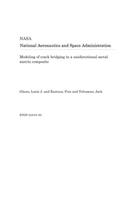
Modeling of Crack Bridging in a Unidirectional Metal Matrix Composite
Series:
The effective fatigue crack driving force and crack opening profiles were determined analytically for fatigue tested unidirectional composite specimens exhibiting fiber bridging. The crack closure pressure due to bridging was modeled using two approaches; the fiber pressure model and the shear lag model. For both closure models, the Bueckner weight function method and the finite element method wer
NaN
VOLUME
English
Paperback

The effective fatigue crack driving force and crack opening profiles were determined analytically for fatigue tested unidirectional composite specimens exhibiting fiber bridging. The crack closure pressure due to bridging was modeled using two approaches; the fiber pressure model and the shear lag model. For both closure models, the Bueckner weight function method and the finite element method were used to calculate crack opening displacements and the crack driving force. The predicted near crack tip opening profile agreed well with the experimentally measured profiles for single edge notch SCS-6/Ti-15-3 metal matrix composite specimens. The numerically determined effective crack driving force, Delta K(sup eff), was calculated using both models to correlate the measure crack growth rate in the composite. The calculated Delta K(sup eff) from both models accounted for the crack bridging by showing a good agreement between the measured fatigue crack growth rates of the bridged composite and that of unreinforced, unbridged titanium matrix alloy specimens. Ghosn, Louis J. and Kantzos, Pete and Telesman, Jack Glenn Research Center RTOP 510-01-50...
Price Comparison [India]
In This Series
Bestseller Manga
Trending NEWS




















